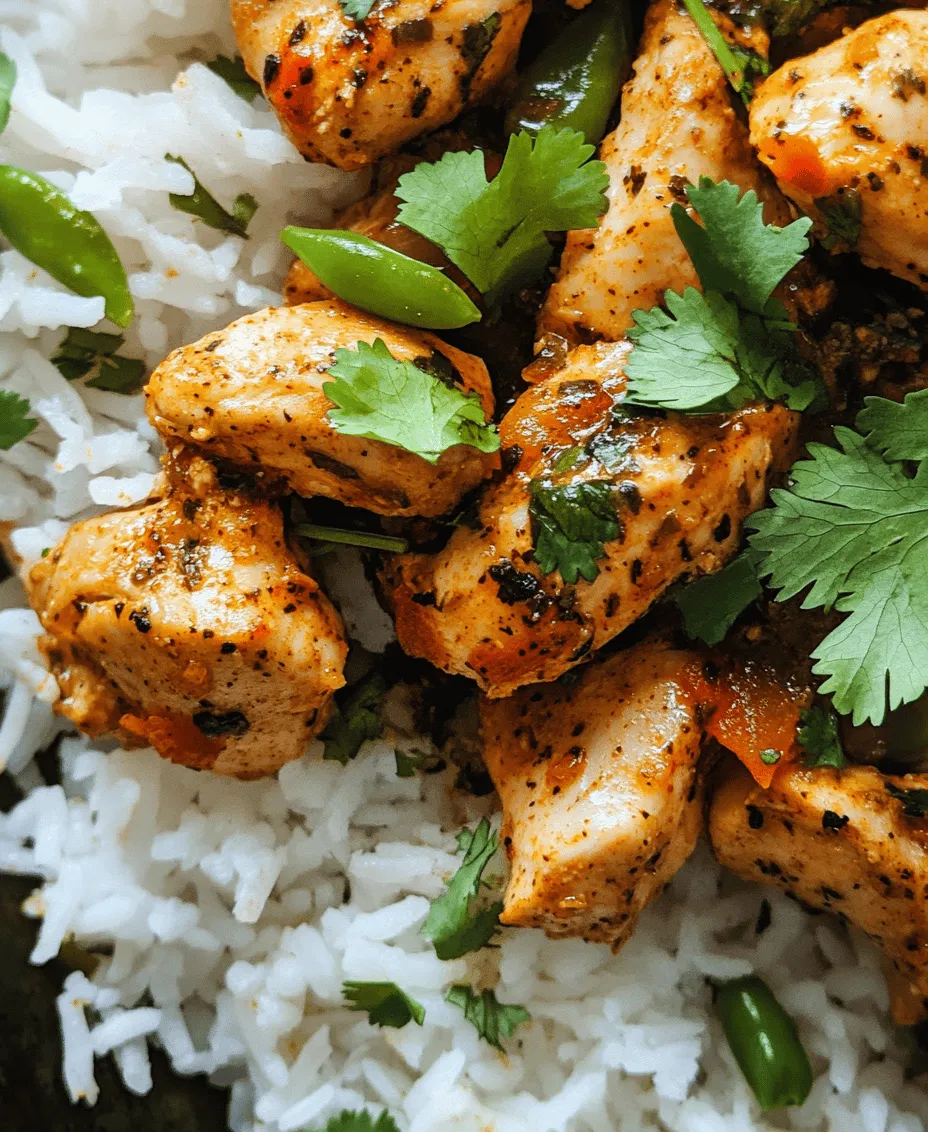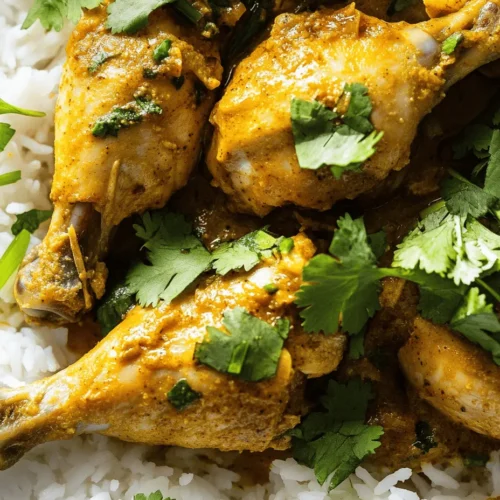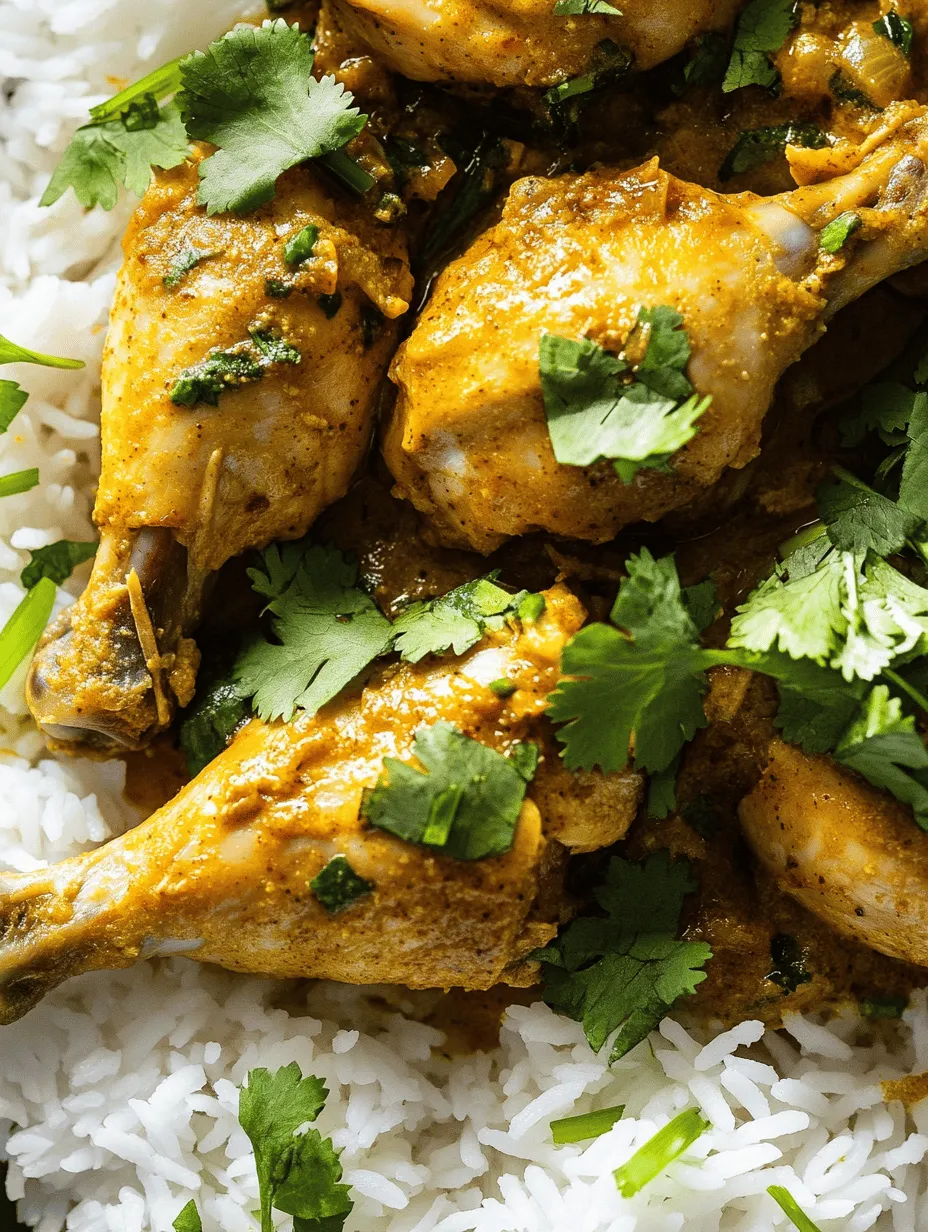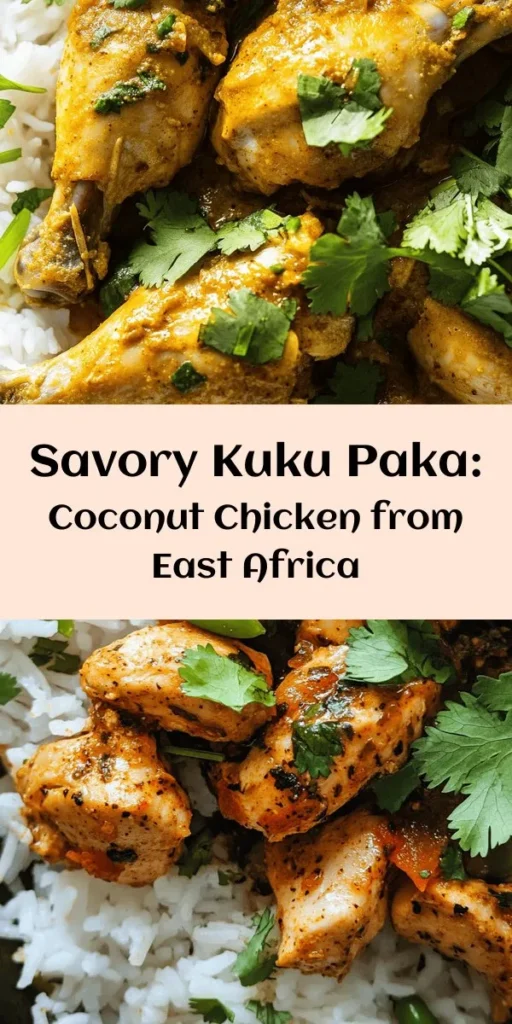Kuku Paka is a beloved dish that hails from the coastal regions of East Africa, particularly the Swahili-speaking areas of Kenya and Tanzania. This delightful coconut chicken dish is more than just a meal; it is a cultural experience that reflects the rich culinary heritage of the region. The name “Kuku Paka” translates to “chicken in coconut,” which beautifully encapsulates the main elements of this dish. As we delve into the preparation of Kuku Paka, you’ll discover the harmonious balance of flavors that make it a favorite among locals and food enthusiasts alike.
The Importance of Coconut Milk in East African Cuisine
Coconut milk is a cornerstone of East African cooking, particularly in coastal areas where coconuts are abundant. This creamy liquid not only adds richness to dishes but also imparts a subtle sweetness that complements savory ingredients. In Kuku Paka, coconut milk plays a pivotal role, providing a luscious base that envelops the chicken in a velvety sauce. Its versatility allows it to pair beautifully with various spices, enhancing the overall flavor profile of the dish.
Beyond its culinary uses, coconut milk is revered for its nutritional benefits as well. It is rich in healthy fats, vitamins, and minerals, making it a wholesome addition to any diet. In Kuku Paka, the coconut milk not only serves as a flavor enhancer but also contributes to the dish’s heartiness, making it a satisfying option for any meal.
Unique Flavors and Appeal of Kuku Paka
What sets Kuku Paka apart from other chicken dishes is its unique blend of flavors. The combination of spices, aromatics, and fresh ingredients creates a complex taste experience that is both comforting and exotic. The spices used in Kuku Paka—such as coriander, cumin, turmeric, and paprika—not only add depth but also evoke the warmth of East African cuisine.
Furthermore, the dish is often garnished with fresh cilantro and a squeeze of lime juice, adding brightness that cuts through the richness of the coconut milk. This balance of flavors makes Kuku Paka a dish that can be enjoyed on various occasions, from family dinners to festive gatherings.
Understanding the Ingredients
To create a truly authentic Kuku Paka, it’s essential to understand the key ingredients that bring this dish to life. Each component plays a significant role in developing the flavors and texture, resulting in a meal that is both delicious and nourishing.
Whole Chicken: Nutritional Benefits and Cooking Properties
The star of Kuku Paka is undoubtedly the whole chicken. Using a whole chicken not only ensures even cooking but also allows for maximum flavor absorption from the marinade and sauce. Whole chickens are often preferred for their juiciness and tenderness, especially when cooked properly.
From a nutritional standpoint, chicken is an excellent source of protein, essential vitamins, and minerals. It provides the body with the necessary nutrients to support muscle growth and maintenance, making it a staple in many diets. Additionally, when prepared with the accompanying spices and coconut milk, chicken becomes a flavorful canvas that showcases the essence of East African cuisine.
Coconut Milk: Its Role in Flavor and Texture
As mentioned earlier, coconut milk is a vital ingredient in Kuku Paka. Its creamy consistency adds a luxurious texture to the dish while also infusing it with a subtly sweet flavor. Coconut milk also acts as a natural tenderizer for the chicken, ensuring that each bite is moist and succulent.
When selecting coconut milk for your Kuku Paka, opt for high-quality, full-fat coconut milk for the best results. This will enhance the richness of the dish and create a velvety sauce that clings beautifully to the chicken, making every mouthful a delightful experience.
Aromatics: The Importance of Onions, Garlic, and Ginger
Aromatics form the backbone of many dishes, and Kuku Paka is no exception. Onions, garlic, and ginger are sautéed to build a flavor base that sets the stage for the rest of the ingredients.
– Onions add sweetness and depth, becoming soft and caramelized during cooking.
– Garlic contributes a pungent, savory note, enhancing the overall flavor profile.
– Ginger adds a hint of warmth and spice, balancing the richness of the coconut milk.
Together, these aromatics create a foundation that elevates Kuku Paka, ensuring that each bite is bursting with flavor.
Spices: How Coriander, Cumin, Turmeric, and Paprika Contribute to the Dish
The spices used in Kuku Paka are essential for achieving its signature taste. Each spice contributes its unique characteristics, making the dish a flavorful delight.
– Coriander provides a citrusy, slightly sweet flavor that brightens the dish.
– Cumin brings warmth and earthiness, grounding the flavors.
– Turmeric adds a beautiful golden hue and a subtle bitterness that complements the coconut milk.
– Paprika contributes a mild heat and a rich color, enhancing the visual appeal of the dish.
By carefully balancing these spices, you create a complex flavor profile that is both intriguing and satisfying.
Fresh Elements: The Impact of Lime Juice and Cilantro on Flavor
Finally, no Kuku Paka would be complete without the addition of fresh ingredients like lime juice and cilantro. These elements bring brightness and freshness to the dish, cutting through the richness of the coconut milk.
– Lime juice adds acidity, which enhances the overall flavor and balances the sweetness of the coconut milk.
– Cilantro provides a fresh, herbaceous note that elevates the dish and adds a pop of color.
When used judiciously, these fresh elements transform Kuku Paka into a vibrant and refreshing meal that is sure to impress.
Preparing for Success: Marinating the Chicken
Marination is a crucial step in preparing Kuku Paka, as it enhances the flavors of the chicken and ensures that each bite is packed with taste. Proper marination allows the spices and aromatics to penetrate the meat, resulting in a more flavorful and tender dish.
Importance of Marination in Enhancing Flavor
When marinated, the chicken absorbs the spices and flavors, creating a harmonious blend that permeates the meat. This process not only enhances the taste but also contributes to the overall juiciness and tenderness of the chicken. A well-marinated chicken will yield a more succulent and flavorful result, making it a key step in the cooking process.
Step-by-Step Guide on How to Marinate Chicken Effectively
1. Prepare the Marinade: In a mixing bowl, combine coconut milk with the spices (coriander, cumin, turmeric, and paprika), minced garlic, grated ginger, and lime juice. Whisk together until well combined.
2. Add the Chicken: Place the whole chicken in a large resealable bag or a deep dish. Pour the marinade over the chicken, ensuring that it is fully coated.
3. Seal and Refrigerate: Seal the bag or cover the dish with plastic wrap and refrigerate. Allow the chicken to marinate for at least 2 hours, but preferably overnight. This allows the flavors to meld and infuse into the meat.
Tips on Timing and Seasoning Adjustments
– Timing: For maximum flavor infusion, aim for a marination time of 8 hours or more. If you’re short on time, at least 2 hours will still yield good results.
– Seasoning Adjustments: Feel free to adjust the spice levels according to your taste. If you prefer a spicier kick, consider adding chili powder or fresh chilies to the marinade.
Discussing Alternatives for Marination
While the coconut milk marinade is traditional, there are alternatives to consider. A yogurt-based marinade can introduce a tangy flavor while also tenderizing the chicken. Simply substitute the coconut milk with plain yogurt and add the spices and aromatics as described. This variation will still result in a delicious Kuku Paka, with a slightly different flavor profile.
Creating the Flavor Base: Sautéing Aromatics
Once your chicken is marinated and ready to go, it’s time to create the flavor base for Kuku Paka by sautéing the aromatics. This step is essential for building depth and complexity in the dish.
The Significance of Sautéing Onions, Garlic, and Ginger
Sautéing the onions, garlic, and ginger releases their natural oils and flavors, creating a fragrant base that enhances the overall taste of the dish. This process caramelizes the sugars in the onions, adding a rich sweetness that balances the spices.
Techniques for Achieving the Perfect Sauté
1. Heat the Oil: In a large, heavy-bottomed pot or Dutch oven, heat a few tablespoons of vegetable oil over medium heat.
2. Add the Onions: Once the oil is hot, add the sliced onions and sauté until they become translucent and begin to caramelize, approximately 5-7 minutes.
3. Incorporate Garlic and Ginger: Add the minced garlic and grated ginger to the pot, stirring frequently to prevent burning. Sauté for an additional 1-2 minutes until fragrant.
How the Sautéing Process Builds Depth of Flavor
The process of sautéing not only cooks the aromatics but also creates a fond at the bottom of the pot. This caramelized layer of flavor will later infuse the chicken and coconut milk, resulting in a dish that is rich and complex.
Brown the Chicken: Sealing in the Juices
After creating the flavor base, the next step involves browning the chicken. This process is crucial for locking in moisture and flavor, resulting in a deliciously juicy Kuku Paka.
Explanation of the Browning Process and Its Impact on Texture and Taste
Browning the chicken creates a Maillard reaction, which enhances the flavor and color of the meat. This step also adds a beautiful golden crust that contributes to the overall texture of the dish.
Tips on Ensuring Even Browning
1. Pat the Chicken Dry: Before browning, make sure to pat the chicken dry with paper towels. This will help achieve a good sear.
2. Don’t Overcrowd the Pot: If your pot is too small, consider browning the chicken in batches to avoid steaming instead of browning.
3. Monitor the Heat: Keep the heat at medium-high to allow for proper browning without burning the aromatics.
How to Recognize When the Chicken is Ready for the Next Step
You’ll know the chicken is ready to move on when it has developed a golden-brown crust on all sides. This should take about 10-15 minutes of cooking.
The Heart of the Dish: Adding Coconut Milk
With the chicken browned and the flavor base established, it’s now time to add the star ingredient—coconut milk. This step is where Kuku Paka truly shines, transforming from a simple chicken dish into a creamy, flavorful delight.
The Role of Coconut Milk in Kuku Paka
Once the coconut milk is added, it brings a luxurious creaminess to the dish, enveloping the chicken in a rich sauce. The sweetness of the coconut milk pairs beautifully with the spices, creating a harmonious blend that is characteristic of Kuku Paka.
As you pour in the coconut milk, you’ll also want to scrape up any browned bits from the bottom of the pot. These bits are packed with flavor and will enhance the sauce, ensuring that every bite is as delicious as the last.
With the coconut milk now incorporated, you are well on your way to creating a delightful Kuku Paka that captures the essence of East African cuisine. Stay tuned for the next part of this article, where we will explore the final cooking steps and tips for serving this delicious dish!

Achieving the Perfect Consistency and Creaminess
Kuku Paka is renowned for its rich and creamy sauce, a delightful combination of coconut milk and spices. Achieving the right consistency is crucial to creating a mouthwatering dish. The key to this creamy texture lies in the careful incorporation of coconut milk, which should be done gradually to prevent curdling.
Incorporating Coconut Milk Without Curdling
To ensure that your coconut milk remains smooth and creamy, it’s best to incorporate it at the right moment during the cooking process. After browning the chicken and sautéing the onions, garlic, and ginger, you should lower the heat before adding the coconut milk. This gentle approach helps keep the temperature low enough to avoid curdling.
Start by adding a small amount of coconut milk to the pan, stirring continuously. Once it’s well mixed, you can gradually add the remaining coconut milk. This method allows the flavors to meld beautifully while maintaining a silky texture. Remember to stir gently to avoid breaking down the coconut milk’s emulsified nature, which is what gives Kuku Paka its luxurious mouthfeel.
Simmering to Perfection: Developing Flavors
One of the most critical steps in preparing Kuku Paka is the simmering process. Slow cooking allows the flavors to develop fully, resulting in a dish that is not only tasty but also aromatic.
The Importance of Slow Cooking in Flavor Development
Simmering the chicken in the coconut milk and spices helps infuse the meat with flavor. The longer you let it simmer, the more robust the taste becomes. Aim for a simmering time of at least 30-45 minutes, allowing the chicken to absorb the spices and the creamy sauce to thicken to your desired consistency.
Tips for Monitoring the Simmering Process
While simmering, it’s essential to keep an eye on the pot. Here are some tips to ensure a successful simmer:
– Temperature Control: Maintain a gentle simmer rather than a rolling boil. High heat can lead to tough chicken and can cause the coconut milk to separate.
– Stir Occasionally: Give the pot a gentle stir every 10 minutes or so. This helps prevent the sauce from sticking to the bottom of the pan and ensures even cooking.
– Check for Tenderness: After the recommended cooking time, test the chicken for doneness. It should be tender and easily fall off the bone.
Signs to Look for to Ensure the Chicken is Tender and Fully Cooked
When Kuku Paka is ready, the chicken should have an internal temperature of at least 165°F (74°C). You should also check that the meat is tender and pulls away easily from the bone. The sauce should be thickened but still pourable, clinging lightly to the chicken.
Final Touches: Adjusting Seasoning and Presentation
Once your Kuku Paka is simmered to perfection, it’s time to add the final touches that elevate the dish’s flavor and presentation.
How to Taste and Adjust Seasoning Effectively
Before serving, taste the sauce and adjust the seasoning as needed. This is an essential step, as it ensures that the flavors are balanced. If the dish tastes flat, consider adding a pinch of salt or a squeeze of lime juice to brighten the flavors. If you prefer a bit more heat, a sprinkle of cayenne pepper or a dash of hot sauce could be the perfect addition.
The Role of Garnishing with Cilantro
Garnishing with fresh cilantro not only enhances the visual appeal of your dish but also adds a burst of fresh flavor. Sprinkle chopped cilantro over the Kuku Paka just before serving to complement the rich coconut sauce. This vibrant green garnish contrasts beautifully with the creamy sauce and adds a refreshing note to each bite.
Serving Suggestions and Pairings
Kuku Paka is a versatile dish that pairs well with various accompaniments, enhancing its flavors and making for a complete meal.
Ideal Types of Rice to Serve with Kuku Paka
Traditionally, Kuku Paka is served with rice, which absorbs the creamy sauce perfectly. The best types of rice to accompany this dish include:
– Basmati Rice: Its long grains and fluffy texture complement the rich sauce.
– Jasmine Rice: This fragrant rice adds an aromatic element that pairs well with the coconut flavors.
– Saffron Rice: For a more luxurious touch, saffron-infused rice adds both color and flavor.
Exploring Side Dishes That Complement the Dish
To create a well-rounded meal, consider serving Kuku Paka with side dishes such as:
– Chapati or Naan: These flatbreads are perfect for scooping up the chicken and sauce.
– Steamed Vegetables: A light side of steamed green beans or broccoli adds color and nutrition.
– Kachumbari: This fresh tomato and onion salad provides a refreshing contrast to the rich flavors of Kuku Paka.
Beverage Pairings That Enhance the Dining Experience
To elevate your meal further, consider beverage pairings that complement Kuku Paka’s rich and creamy profile. Here are some great options:
– Chilled Coconut Water: This refreshing drink enhances the coconut flavor and is hydrating.
– Spiced Chai: A lightly spiced chai can add warmth and complexity to your meal.
– White Wine: A crisp white wine like Sauvignon Blanc can pair well with the dish, cutting through the richness of the coconut milk.
Cultural Significance of Kuku Paka in East African Cuisine
Kuku Paka is more than just a dish; it holds a special place in the hearts of many in East Africa, particularly in coastal regions where coconut and spices are abundant.
Historical Background of Kuku Paka and Its Regional Variations
Originating from the Swahili coast, Kuku Paka reflects the diverse influences of Arab, Indian, and local cuisines. The dish has many regional adaptations, with variations in spices and preparation methods. In some areas, you might find Kuku Paka spiced with additional ingredients like cardamom or cloves, showcasing the culinary creativity of the region.
The Role of Coconut Chicken in Celebrations and Gatherings
Kuku Paka is often served during special occasions and gatherings, symbolizing hospitality and the joy of sharing good food with family and friends. It is commonly enjoyed at weddings, festivals, and communal feasts, bringing people together over a delicious meal.
Personal Anecdotes Related to Enjoying Kuku Paka
Many who grew up in East Africa have fond memories of Kuku Paka being prepared by their mothers or grandmothers. The aroma of simmering spices and coconut milk filling the home evokes nostalgia and warmth. Sharing Kuku Paka with loved ones is not just about the food; it’s about the connections and stories that come alive around the dining table.
Nutritional Information and Health Benefits
Kuku Paka is not only delicious but also offers several health benefits due to its wholesome ingredients.
Breakdown of the Nutritional Profile Per Serving
A typical serving of Kuku Paka contains approximately:
– Calories: 400-500 (depending on the portion size and ingredients used)
– Protein: 30g (from chicken)
– Fat: 25g (primarily from coconut milk)
– Carbohydrates: 20-30g (depending on rice side)
Health Benefits of the Key Ingredients
– Coconut Milk: Rich in healthy fats and fiber, coconut milk is known for its anti-inflammatory properties and can support heart health.
– Chicken: A great source of lean protein, chicken is essential for muscle repair and growth.
– Spices: Ingredients like ginger and garlic are known for their antioxidant and anti-inflammatory properties, contributing to overall health.
Discussion of Dietary Considerations
Kuku Paka is naturally gluten-free and dairy-free, making it a suitable option for those with dietary restrictions. However, if you’re looking to reduce calories, consider using light coconut milk or reducing the portion size without sacrificing flavor.
Conclusion: Embracing the Flavors of Kuku Paka
Kuku Paka is a celebration of flavors that brings the essence of East African cuisine to your table. Its rich, creamy sauce, tender chicken, and aromatic spices create a delightful experience that is both comforting and exotic. The cultural significance of this dish, often enjoyed during gatherings and celebrations, adds to its charm.
As you embark on making Kuku Paka at home, don’t be afraid to experiment with the recipe to make it your own. Whether adjusting the spices, trying different side dishes, or exploring regional variations, the joy of cooking lies in creativity and personal touch.
Embrace the vibrant flavors of Kuku Paka and enjoy the process of sharing this culinary gem with your family and friends. The heartwarming experience of preparing and savoring East African cuisine at home is one that will surely create lasting memories.



